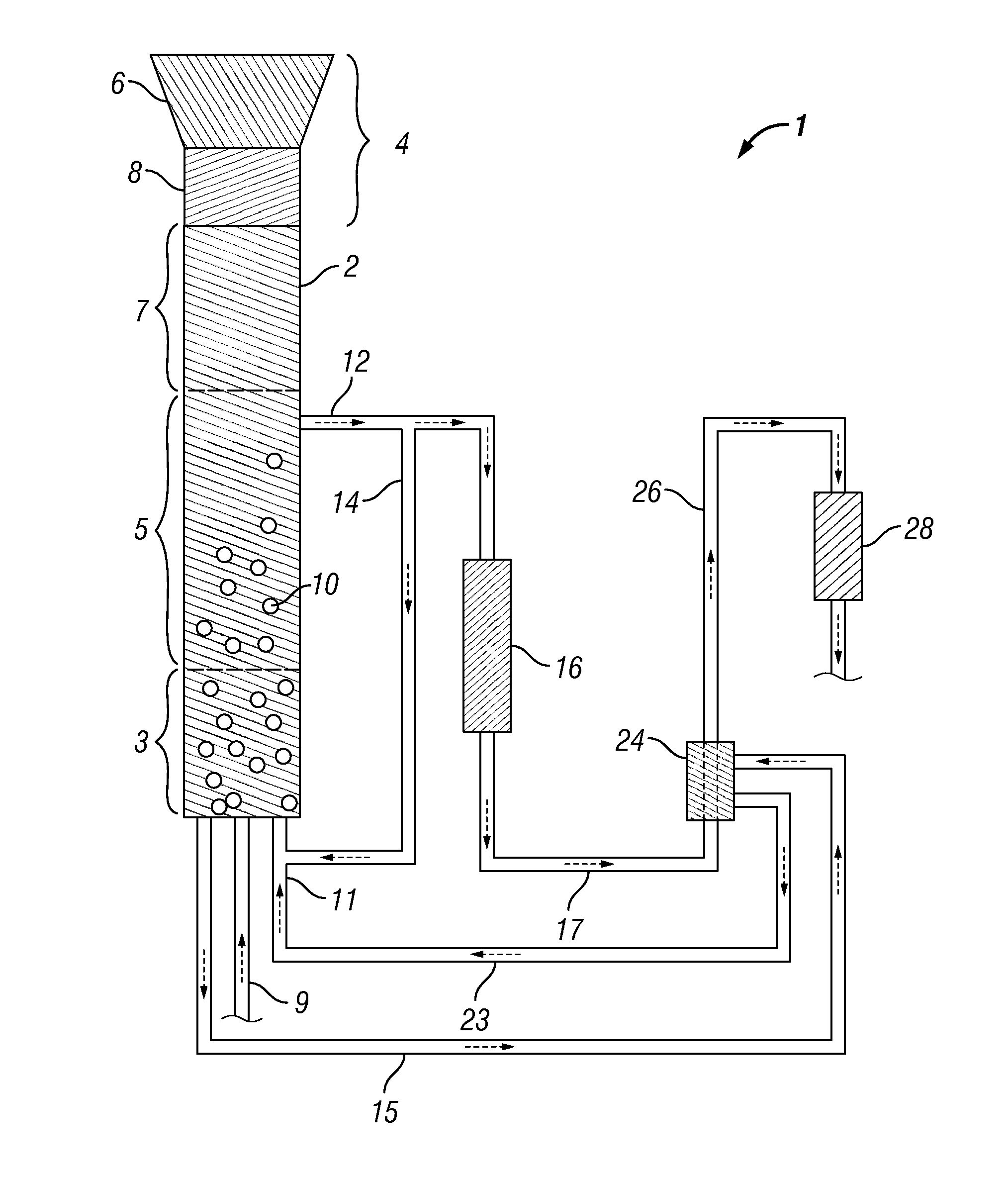Method and Systems for Procesing Lignin During Hydrothermal Digestion of Cellulosic Biomass Solids While Producing a Monohydric Alcohol Feed
- Summary
- Abstract
- Description
- Claims
- Application Information
AI Technical Summary
Benefits of technology
Problems solved by technology
Method used
Image
Examples
example 1
Formation and Thermal Treatment of a Phenolics Liquid Phase in the Presence of an Aqueous Phase
[0121]A 100 mL Parr reactor was charged with a solvent mixture comprising 29.3 grams of 1,2-propylene glycol, 3.3 grams of ethylene glycol, and 32.5 grams of deionized water. 0.752 grams of nickel-oxide promoted cobalt molybdate catalyst was then added (DC-2534, Criterion Catalyst & Technologies L.P., containing 1-10% cobalt oxide and molybdenum trioxide (up to 30 wt. %) on alumina, and less than 2% nickel). The catalyst was previously sulfided as described in United States Patent Application Publication 2010 / 0236988, which is incorporated herein by reference in its entirety. The reactor was then charged with 6.05 grams of southern pine mini-chips (39% moisture, nominal dimensions of 3 mm×5 mm×5 mm) and 0.18 grams of potassium carbonate buffer, before pressurizing with 765 psia of hydrogen. The stirred reactor was heated to 190° C. for 1 hour, followed by ramping over 15 minutes to a tempe...
example 2
Viscosity of the Phenolics Liquid Phase
[0124]The cycles for Example 1 were repeated through cycle 29, after which a one gram sample of the phenolics liquid phase was placed in a 1 ounce vial and allowed to cool to room temperature. No flow was observed upon tipping of the vial by 90 degrees. The vial was heated to 110° C. in a block heater, but again no flow was observed. The viscosity at 110° C. was too large to measure and estimated to be greater than 10,000 cP, based on flow behavior observed in an analogous test with high viscosity model fluid. Acetone solubility of the phenolics liquid phase at a 10:1 solvent / sample ratio was negligible.
[0125]After charging with 750 psig of hydrogen, the reactor was heated at 270° C. for 23.5 hours after a normal 5 hour cycle. After hydrotreating, a sample of the phenolics liquid phase exhibited a falling film viscosity comparable to that of glycerol (approximately 1000 cP at 25° C.), after re-heating to 108° C. in a block heater. Upon tipping ...
example 3
Multi-Cycle Reaction with No Thermal Treatment
[0126]A 100 mL Parr reactor was charged with 60.18 grams of deionized water solvent and 0.754 grams of the sulfided nickel-oxide promoted cobalt molybdate catalyst described in Example 1. The reactor was charged with 5.05 grams of southern pine mini-chips (39% moisture having nominal dimensions of 3 mm×5 mm×5 mm) and 0.195 grams of potassium carbonate buffer, before pressurizing with 766 psia of hydrogen. The stirred reactor was heated to 190° C. for 1 hour before ramping over 15 minutes to a temperature of 250° C. and holding to complete a 5 hour cycle. Reaction products including mono-oxygenated compounds, glycerol, propylene glycol, ethylene glycol, and other oxygenated, alkane and organic acids were observed. Subsequent cycles were conducted as described in Example 1.
[0127]After eight cycles, the 0.5 micron sintered metal dip tube plugged, and it was not possible to sample the mixed reaction phases. After cool down, a bottoms phase w...
PUM
| Property | Measurement | Unit |
|---|---|---|
| Temperature | aaaaa | aaaaa |
| Temperature | aaaaa | aaaaa |
| Temperature | aaaaa | aaaaa |
Abstract
Description
Claims
Application Information
 Login to View More
Login to View More - R&D
- Intellectual Property
- Life Sciences
- Materials
- Tech Scout
- Unparalleled Data Quality
- Higher Quality Content
- 60% Fewer Hallucinations
Browse by: Latest US Patents, China's latest patents, Technical Efficacy Thesaurus, Application Domain, Technology Topic, Popular Technical Reports.
© 2025 PatSnap. All rights reserved.Legal|Privacy policy|Modern Slavery Act Transparency Statement|Sitemap|About US| Contact US: help@patsnap.com

